Paint Removal from Historic Timbers
Ben Kirk
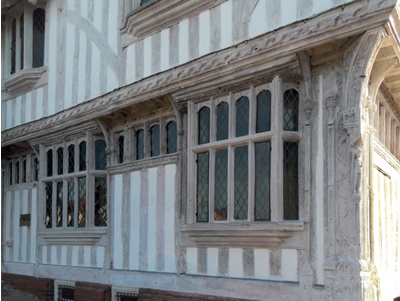 |
|
| Limewashed timbers at the Guildhall of Corpus Christi, Lavenham, Suffolk: here the historic importance of the decoration is obvious, but careful investigation is vital where later paint layers are to be removed as they often hide early schemes. |
Removing paint from historic timbers is difficult and some techniques can be highly damaging to the timber itself, particularly in the wrong hands. Furthermore, although paint applied in the recent past may be considered historically inappropriate, it may overlie older decorative schemes of great historic significance.
In England, the decorative painting of internal timbers began in the late 15th and early 16th centuries as enclosed fireplaces and glazed windows became more commonplace, creating homes which were better lit and freer from smoke and soot.
Especially in the south east and east of England, it was common for external timbers to be limewashed, along with the infill panels, with a mixture of ‘fat’ (non-hydraulic) lime and a binder such as tallow. Some timbers were painted, often in reds, with a colour wash made by mixing the limewash with animal glue size or stale beer and colouring it with earth pigments such as ochre. Many timbers, however, were left completely unpainted.
Lead paints consisting of finely ground white lead pigment (lead carbonate or lead sulphate) mixed with boiled linseed oil and thinned with turpentine were used from the 17th century. They have a distinctive character, drying with a slight sheen and retaining brush marks. When they weather externally lead paints tend to become ‘chalky’ rather than peeling.
White spirits replaced turpentine in the 19th century and barites (barium sulphate) were added as a pigment extender. By the middle of the 19th century the harmful nature of lead was better understood and zinc oxide became widely used, although this proved to be less flexible than lead-based paint and so was often mixed with lead as a compromise. In the early 20th century non-toxic titanium dioxide was introduced to replace lead, while alkyd resins replaced linseed oil. By the mid1960s lead had been removed from most paints and by the 1980s it had been removed from all paints on general sale.
In many historic buildings in the UK exposed structural timbers, both internally and externally, are painted, usually in black, providing the black and white effect that is typical of so many English villages. It has been suggested that painting timbers black was a 19th-century fashion, possibly inspired by earlier precedents, and that the liquids from coal and tar deposits were used. However, closer inspection often shows that the paint is more modern black gloss. This can give the timber a dated appearance that seems out of character with the softer palettes of other materials in the building.
There is now an increasing desire to remove this paint to reveal the original timber, typically internally but sometimes externally too. This is often a welcome change which allows the original timber to be seen and it can dramatically change the character of the building. It does, however, bring with it a number of issues and challenges.
The surface of the timber may contain archaeological evidence of the building’s construction and development such as carpenters’ marks, tool marks, ritual marks and early decorative finishes, often obscured by many layers of paint.
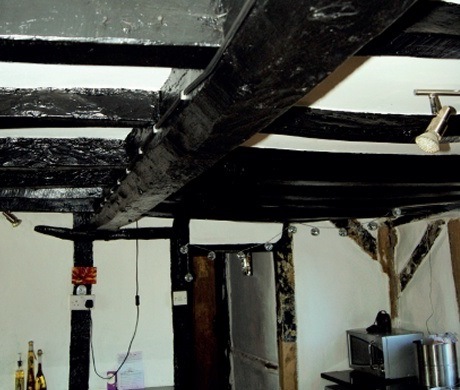 |
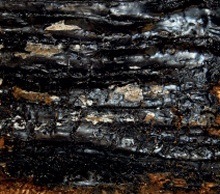 |
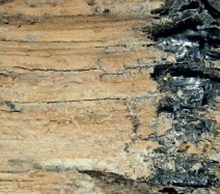 |
|
| Typical heavy black gloss paintwork on internal ceiling joists | Before and after sandblasting |
Even where no archaeological features exist, the aesthetic value of the surface should also be considered. The patina and the presence of a cohesive and unaltered surface have a value that is easily lost if care is not taken. Over-aggressive cleaning can cause irreversible damage to the timber’s surface and discolouration from chemical cleaning agents can be difficult to remove without risking further damage.
The type of wood (hardwood or softwood), species, rate of growth, type of conversion and quantity of sapwood all determine the characteristics of the timber’s surface and how it will respond to the various paint removal methods.
If the decision is taken to remove paint, it is vital that the chosen method ensures maximum retention of the underlying surface.
PAINT REMOVAL METHODS
Paint removal methods fall into two main groups: air abrasive and chemical. These are explored in more detail below.
If the building is listed, the removal of paint will always require listed building consent because it changes the character of the building. There are many horror stories about poor attempts at paint removal by so-called specialists which have led to serious and irreversible damage to the timber. It is a process that requires careful consideration and every job will require a different approach. The nature of the paint and the underlying substrate should all be taken into account before choosing a suitable method.
Many conservation officers will resist any sort of abrasive method (especially sandblasting) while others will consider it when presented with a detailed method statement prepared by a conservation specialist, and provided the work is carried out by an experienced contractor. A sample panel is often required before works can commence.
There is a third option which is becoming quite popular: repainting the timber to look like original timber. A few companies offer this service and wood graining can look quite convincing. The arguments for and against over painting are too involved to be explored here but it is worth noting that this option exists.
AIR ABRASIVE METHODS
Dry abrasive blasting (‘sand blasting’) In this method a dry abrasive is fed into a hopper and a jet of high pressure air with a steady flow of dry abrasive is directed through a nozzle against the substrate. The use of dry abrasive produces a great deal of dust and the spent abrasive must be cleaned up and disposed of afterwards.
The type and size of aggregate, flow rate and pressure can all be varied, as can the nozzle size, distance from and angle to the substrate.
Dry ice blasting In this method solid CO2, which is formed into 3mm rice-like pellets, is accelerated to supersonic speeds via a blasting unit and applied using a hand-held blasting gun through a fragmenting nozzle. Upon impact the dry ice immediately turns from its solid state into carbon dioxide vapour expanding by up to 540 times its volume. The energy produced by the conversion of solid to vapour is considerable and is responsible for much of the cleaning process. The vapour disappears back into the atmosphere, leaving only the removed contaminant for disposal.
Wet abrasive blasting Including a small proportion of water in the blast results in less dust than the dry version, so it is easier to see and control its effect. One system commonly used by conservation contractors creates a swirling vortex using a mixture of low air pressure, a small quantity of water and an inert fine granulate such as calcium carbonate. The nozzle cone is interchangeable, with a larger one for cleaning larger areas and a smaller one for more intricate detail. The pressure, type of abrasive and ratio of abrasive to water can also be varied, as can the distance from and angle to the substrate.
CHEMICAL METHODS
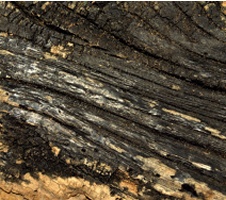 |
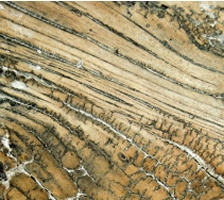 |
|
| Timber surface before and after chemical poultice application | ||
There are many chemical products on the market with differing characteristics and varying degrees of effectiveness depending on the paint type and substrate being cleaned.
Many of the chemical removers are applied to the surface in a poultice at 3–6mm thick according to the thickness of the paint layers. They are then wrapped in cling film or similar material and left for a period of hours, or days for thick layers, before being removed. Being absorbent, the poultice draws off the paint layer, most of which peels off with the poultice. The residue may then be removed with water and a scrubbing brush. Because no scraping is necessary it is possible to completely remove paint even from ornate work without any damage, and it is quite an effective method for drawing paint out of the wood grain.
Alternatives to poultices include gels and pastes which are thick enough to be used on horizontal ceiling beams and are often thixotropic – that is to say that they become more fluid when agitated and less fluid when left.
Some of these chemicals are alkali-based and can be highly caustic, while others are solvent based, so it’s important to carefully consider the environment in which they are being used and the health and safety precautions required. This may include the need to ensure that the area is well ventilated and that the correct personal protection is used. Water-based products with a low VOC (volatile organic compound) content are available which are less damaging to human health and can be used in areas where ventilation is poor.
SELECTING THE APPROPRIATE METHOD
There are many factors to consider when selecting the most suitable method – more than can be covered in full here. Some of the key considerations are explored below.
CONSERVATION CONSIDERATIONS
These should include the level of damage that the process causes to the surface of the substrate and any markings, carvings or mouldings; and the degree to which it raises the grain or otherwise alters the aesthetic appearance of the timber. The impact on associated adjacent materials such as glass, brick and plaster should also be considered.
The ability to control the method and to remove individual layers of paint without damage to earlier finishes is key, as is the ability to vary the aggressiveness of the method according to characteristics of the timber such as the degree of heartwood and sapwood, or whether the timber is sound or has suffered decay.
The requirement for an experienced and skilled operative is a practical consideration but also has conservation implications because a method deemed suitable in the right hands may be highly damaging in the wrong ones.
PRACTICAL CONSIDERATIONS
The ability to use the method in an enclosed space is a key consideration, not only in terms of health and safety but also in its impact on the work of other trades on site. There are of course many other health and safety implications, such as the use of personal protective equipment and the need to work at height as well as the requirement for training, risk assessment and COSHH (Control of Substances Hazardous to Health) considerations. The effect of chemicals and blasting media on the environment should also be taken into account.
The various complications of in situ use should also be considered, such as working on the underside of ceiling joists, working outside in bad weather and working in buildings that need to remain habitable during the works.
Finally, cost should be considered. In a commercial industry this is a key consideration which few clients can ignore, and while it should not be the overriding factor in selecting a paint removal method, clearly it will influence decisions.
LET THE BUILDING SPECIFY THE REPAIR
Every circumstance will be different and the variables of the specific site should be used to determine the most suitable method. The various advantages and disadvantages of the methods and their suitability on different paints and substrates should be balanced and, where necessary, the use of more than one method should be considered.
For example, the project might be a full-building renovation which is scheduled to include paint removal from a heavily moulded spine beam supporting closely spaced joists in a large hall. In this context, one might select a chemical poultice remover for its ability to remove the paint from the moulded areas of the spine beam where dwelling with an aggressive mechanical method could cause damage.
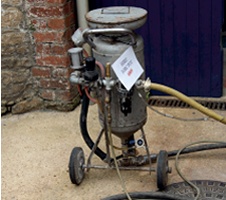 |
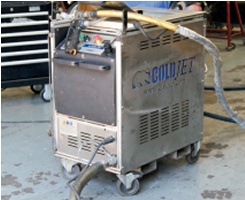 |
|
| Dry ice blasting equipment | Low pressure vortex hopper |
This might be followed by low-pressure air or air/water abrasive blasting on the flat areas only, by a highly skilled operative, so that the work can be completed more quickly, and in the knowledge that the building will be cleaned thoroughly before completion of the works.
In the same circumstances but where the building will remain habitable, sandblasting could be replaced with dry ice blasting, which is fast and relatively clean with no expelled aggregate (although it is likely to cost more).
In all cases a test patch should be carried out. This should be used to provide a specification for the paint removal which should then be presented to the relevant conservation body (usually the local authority conservation officer) and permission for the works should be sought. The works must then be carried out in accordance with this specification and by a skilled and trained operative.
One of the governing principles of timber frame repair can equally be applied to the removal of paint. When repairing timber one should look at the species, type and method of conversion, speed of growth and direction of grain of the host timber in order to specify a suitable repair timber. This ethic of letting the building specify the repairs can equally be applied to paint removal.
Finally, it is also important to bear in mind that the painted surface being removed may also be of archaeological value as the stratigraphy of the paint will give a historical record of the decoration. There is clearly a value therefore in keeping representative areas of paint, perhaps in inconspicuous areas to preserve this evidence in situ.



